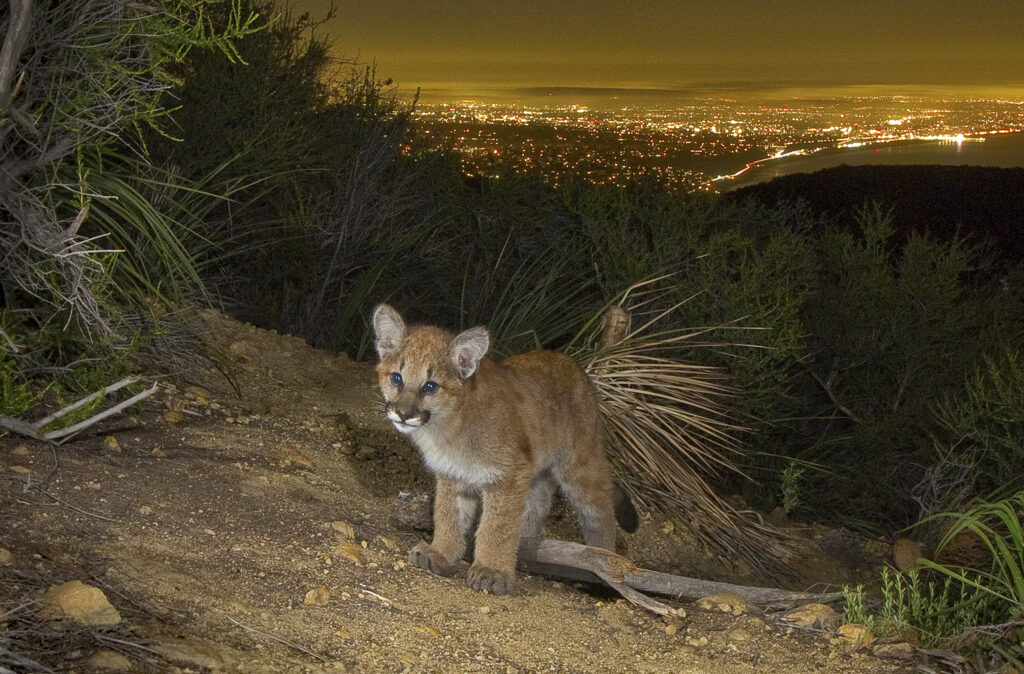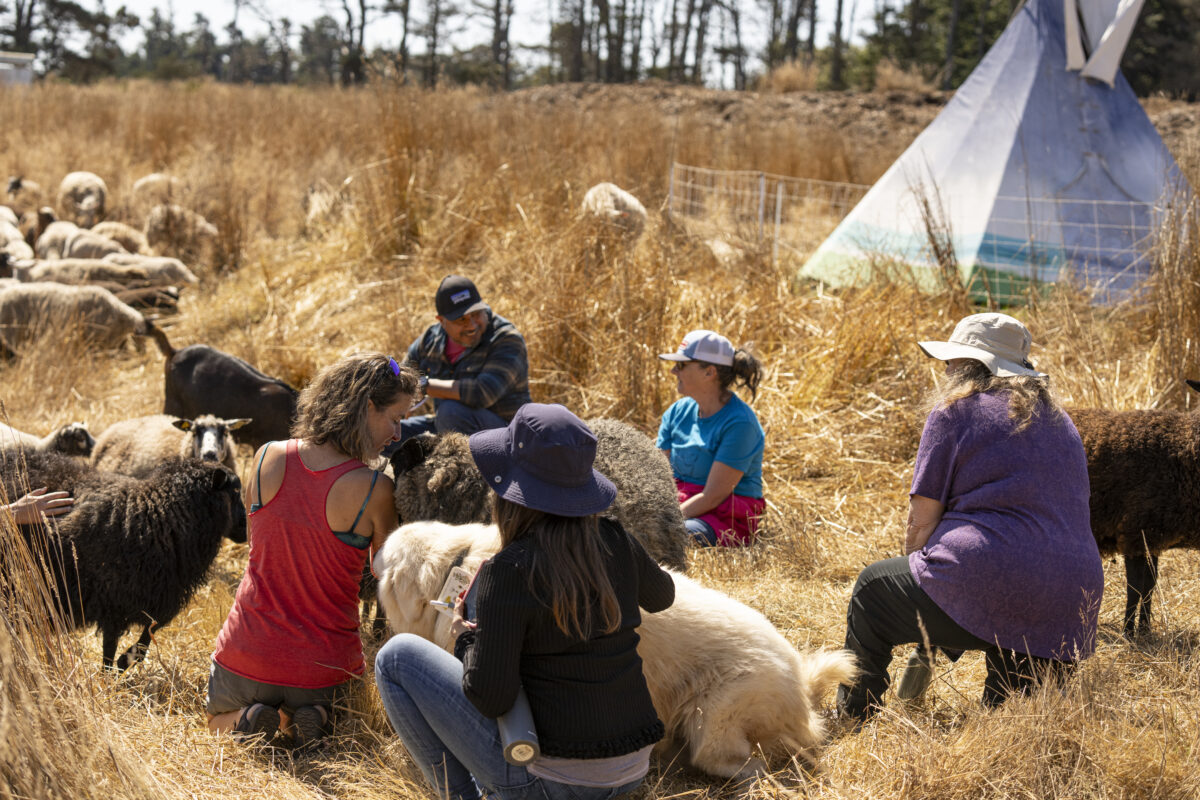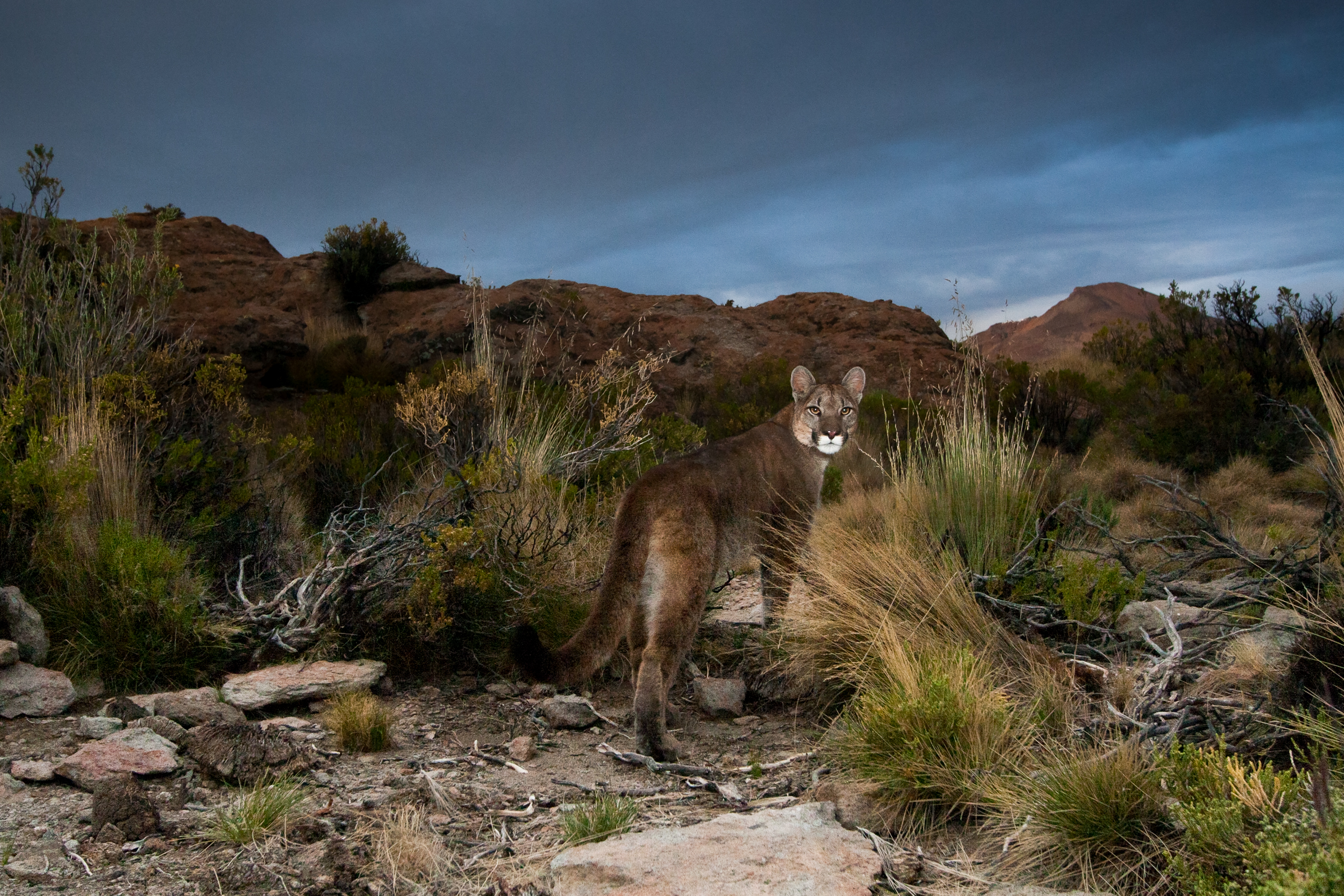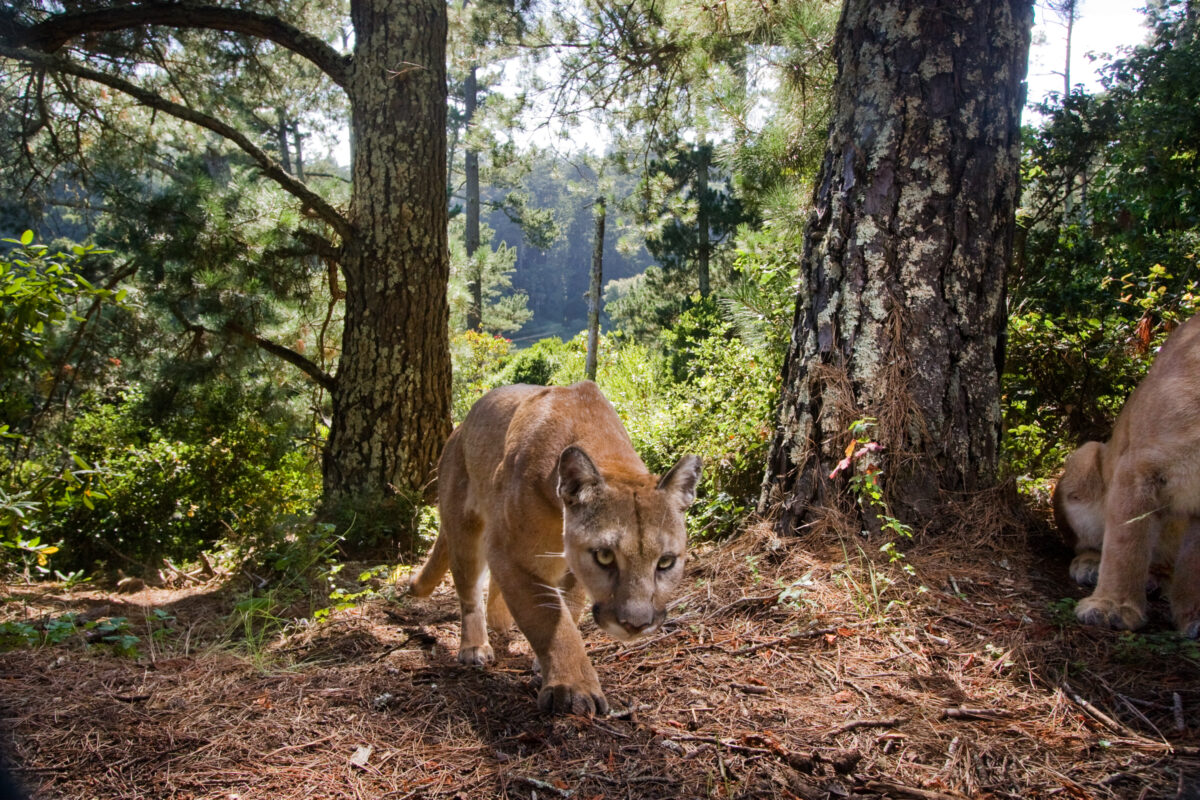Wildlife agencies, mountain lion hunters, and conservationists make a lot of claims about mountain lion hunting. Ultimately, their claims are a lot wrong (but also a little right). The United States has a long history of hunting mountain lions. Before 1950, rapid and dramatic changes to land use, overhunting of prey, and bounty hunts for mountain lions led to the extirpation of cougars from much of the US. Mountain lions have recovered in some of these areas thanks to protections for both them and their prey species. However, in many western states, mountain lions are classified as a game animal that can be hunted for sport.
Here are common claims made by wildlife agencies, lion hunters, and conservationists about the necessity of hunting mountain lions:
- Mountain lion populations need to be reduced or controlled—through hunting—to prevent mountain lions from damaging the deer or elk population.
- Mountain lion populations can be easily reduced or controlled through recreational hunting.
- Mountain lion hunting will reduce conflicts with livestock, pets, and people.
- Mountain lion hunting will improve the social acceptance of living with mountain lions.
The bases for these claims are varied, and include anecdotal evidence, some scientific evidence, intuition, and a sense of “justice.”
Claim 1: Mountain lion populations need to be reduced or controlled—through hunting—to prevent mountain lions from damaging the deer or elk population.
Scientific research and published peer-reviewed studies about the ecology of mountain lions do not support this claim. The first falsehood is the assumption that mountain lions will overpopulate or need control to begin with. The size of a mountain lion population is limited by food and territorial behavior. Based on these factors, a given area will have a carrying capacity of mountain lions that it can support; the lion population won’t rise above this capacity. Animal populations generally follow this type of population growth, with slower-breeding species (“k-selected” in biology terminology) reaching carrying capacity more gradually.

The carrying capacity of the environment can change for mountain lions if the environment changes, but ultimately overpopulation will not occur because of conflicts between lions and because they can move away from areas with too little food.
For some people, a stable population of lions on a landscape still feels like “too many,” leading to calls for population reductions. Not only is it difficult to reduce mountain lion populations through anything less than drastic levels of hunting (see Claim 2 below) but removing lions can reduce community safety as well (see Claim 3 below). Further, research tells us that lions have tremendous value to local food webs and ecosystems, so reducing lion populations through aggressive hunting damages those ecosystems.
Claim 2: Mountain lion populations can be easily reduced or controlled through recreational hunting.
This claim is complicated. Mountain lion populations do not need to be hunted to control their population, and hunting will only reduce their numbers if enormous numbers are killed (i.e., if the entire population is nearly extirpated).
Hunted mountain lion populations often exhibit source-sink dynamics. When young mountain lions leave their mother’s territories to find their own, males and females disperse, with males often traveling a hundred miles or more to find new homes. A heavily hunted lion population (or one in which more lions die from other causes than are born there) is called a sink. Males from less hunted populations are a source because they fill recently vacated territory in a nearby sink population. Source-sink dynamics account for why a heavily hunted population may never actually have fewer mountain lions.
In most areas of the American West, there is usually a source available to provide for sinks. Game reserves, nearby states with lighter levels of hunting, and areas of the landscape that are difficult for hunters to access are common factors that create a source population within dispersal distance of a sink. Significant disruptions to the mountain lion population can happen in a sink population even while immigration maintains levels at the carrying capacity, and in some cases that disruption increases the local mountain lion population.
Of course it is possible to eradicate mountain lions. Florida is now the only state east of the Mississippi River that has a breeding population of cougars (i.e., the Florida panther). However, cougars weren’t extirpated from the eastern US because of sport hunting. They were eradicated because their prey (e.g. deer and elk) were overhunted, their habitat was dramatically altered/reduced, and governments put bounties on their heads. In the western US, states with hunting programs that aim to control or reduce mountain lion populations are unnecessary and ineffective for their intended outcome.

Claim 3: Mountain lion hunting will reduce conflicts with livestock, pets, and people.
A great deal of research has gone into exploring whether killing carnivores reduces the likelihood of conflict with people, with mixed results. While more robust studies are needed in this area, recent analyses of the existing research concluded that killing carnivores doesn’t reduce conflict — and in fact may make it worse, leading to decreased safety for livestock, pets, and people.
Source-sink dynamics explain this conclusion. Killing a mountain lion doesn’t mean that there is one less lion with which to have conflict. It simply means there is an empty territory for other, younger and less experienced mountain lions to fill.
Non-lethal methods to protect livestock and pets (such as night-penning, fences, livestock guardian dogs, and motion sensor lights) will likely provide better chances of long-term success because these methods do not rely on the unrealistic absence of mountain lions. Learn more about coexisting with mountain lions here.
In terms of human safety, mountain lion attacks are an incredibly rare event. You have a greater chance of being struck by lightning than attacked by a cougar. Research on the subject is admittedly slim, due to a thankfully tiny sample size. Read more about the risk of mountain lion attacks here.
If mountain lions exist in the wild, there will always be a real, though minuscule, risk of attack. The recreational hunting of mountain lions won’t change that, unless every lion is eradicated. A world without wild animals, including carnivores like mountain lions, would be an ecological catastrophe.

Claim 4: Mountain lion hunting will improve the social acceptance of living with mountain lions.
This is a frequent claim made in regions where people are struggling to coexist with mountain lions, either due to livestock losses or fear of them as predators. Increased mountain lion hunting is often offered as a salve for these issues, even if it won’t actually fix the problem. Hunting won’t reduce conflict, and it usually won’t successfully reduce the population. Hunting is offered not to fix the problem but to make people feel better, or for retribution after livestock is lost.
Regardless, hunting won’t solve these problems. But knowing more about these cats and learning to live with them peacefully might. To learn more about mountain lion biology and behavior, check out the Mountain Lion Foundation’s new resource: Essential Guide to Recent Scientific Research on Mountain Lions.
References
Cooley, Hilary S, Robert B Wielgus, Gary M Koehler, Hugh S Robinson, and Benjamin T Maletzke. 2009. “Does Hunting Regulate Cougar Populations? A Test of the Compensatory Mortality Hypothesis.” Ecology 90 (10): 2913–21. Dellinger, Justin A, Daniel K Macon, Jaime L Rudd, Deana L Clifford, and Steven G Torres. 2021. “Temporal Trends and Drivers of Mountain Lion Depredation in California, USA.” Human Wildlife Interactions 15 (1). https://doi.org/https://doi.org/10.26077/c5bb-de20
Elbroch, L. Mark, and Adrian Treves. 2023. “Why Might Removing Carnivores Maintain or Increase Risks for Domestic Animals?” Biological Conservation 283 (July): 110106. https://doi.org/10.1016/j.biocon.2023.110106.
Hawley, Jason E., Paul W. Rego, Adrian P. Wydeven, Michael K. Schwartz, Tabitha C. Viner, Roland Kays, Kristine L. Pilgrim, and Jonathan A. Jenks. 2016. “Long-Distance Dispersal of a Subadult Male Cougar from South Dakota to Connecticut Documented with DNA Evidence.” Journal of Mammalogy 97 (5): 1435–40. https://doi.org/10.1093/jmammal/gyw088.
Huffmeyer, Audra A., Jeff A. Sikich, T. Winston Vickers, Seth P.D. Riley, and Robert K. Wayne. 2022. “First Reproductive Signs of Inbreeding Depression in Southern California Male Mountain Lions (Puma Concolor).” Theriogenology 177 (January): 157–64. https://doi.org/10.1016/j.theriogenology.2021.10.016.
Larue, Michelle A., Clayton K. Nielsen, and Brent S. Pease. 2019. “Increases in Midwestern Cougars despite Harvest in a Source Population.” The Journal of Wildlife Management 83 (6): 1306–13. https://doi.org/10.1002/jwmg.21693.
Laundré, John W., and Christopher Papouchis. 2020. “The Elephant in the Room: What Can We Learn from California Regarding the Use of Sport Hunting of Pumas (Puma Concolor) as a Management Tool?” PLoS ONE 15 (2). https://doi.org/10.1371/journal.pone.0224638. 20
Lennox, Robert J., Austin J. Gallagher, Euan G. Ritchie, and Steven J. Cooke. 2018. “Evaluating the Efficacy of Predator Removal in a Conflict Prone World.” Biological Conservation 224 (August): 277–89. https://doi.org/10.1016/J.BIOCON.2018.05.003.
Logan, Kenneth A. 2019. “Puma Population Limitation and Regulation: What Matters in Puma Management?” Journal of Wildlife Management 83 (8): 1652–66. https://doi.org/10.1002/jwmg.21753
Robinson, H. S., Wielgus, R. B., Cooley, H. S., and Cooley, S. W. (2008). Sink populations in carnivore management: Cougar demography and immigration in a hunted population. Ecological Applications, 18(4), 1028– 1037. https://doi.org/10.1890/07-0352.1
Teichman, Kristine J., Bogdan Cristescu, and Chris T. Darimont. 2016. “Hunting as a Management Tool? Cougar-Human Conflict Is Positively Related to Trophy Hunting.” BMC Ecology 16 (1). https://doi.org/10.1186/s12898-016-0098-4.



 Facebook
Facebook Twitter
Twitter Send Email
Send Email

